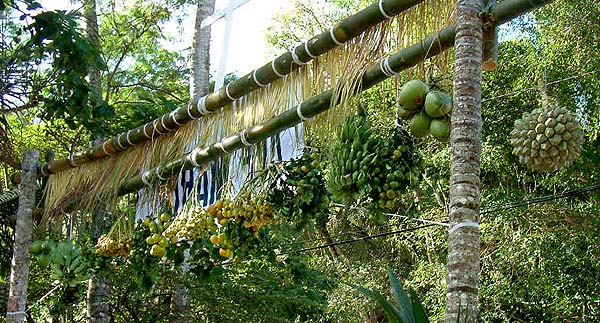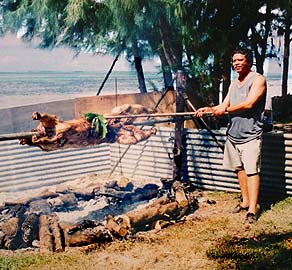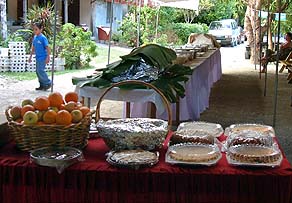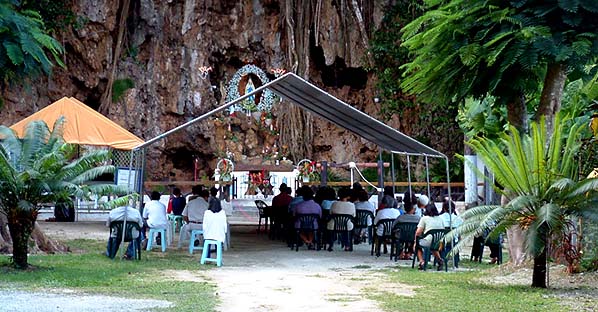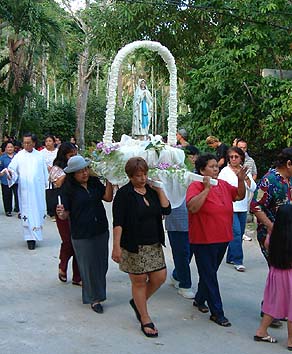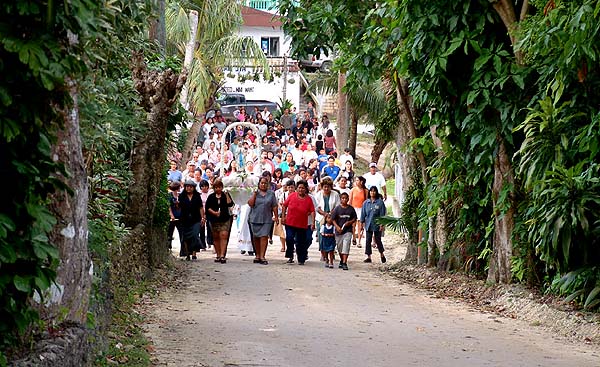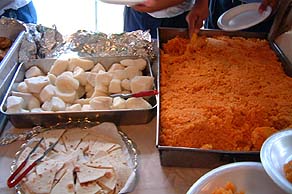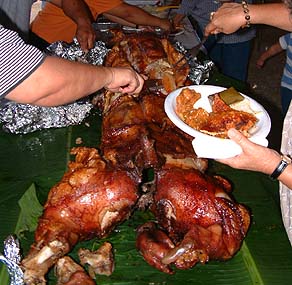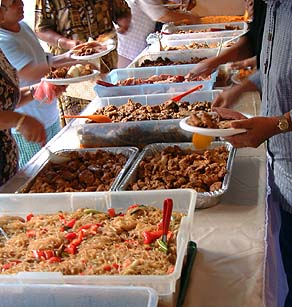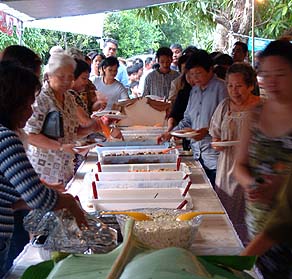 |
 |
 |
|||||
|
|
|
|
|
|
|
|
|
|
|
|||||||
|
|
|
|
|
|
“Every year each village celebrates fiesta,” Ben says, “so every year we have something like seven to nine fiestas throughout the villages of Saipan. For the village of Tanapag, we celebrate our fiesta in the second week of October, and it coincides with the same fiesta date for Rota. "Rota celebrates the same fiesta, though with a different saint patron than the village here in Tanapag, but the second week of October is usually the same. A lot of us cannot go to Rota to attend their fiesta, and a lot of the Rota people cannot make it here to attend our fiesta, but we invite island-wide. We advertise it today using all the media on the island, the radio, the newspaper, and the television. We advertise for people to come and enjoy our celebrations of our Patron."
|
||
|
|
||
“Fiesta is a lot of work. We go get and slaughter animals and prepare them. If it is a cow, we would have to skin it down at the beach, dress the animal, then prepare to debone it, and there are cooks assigned to different tasks. "Some cooks would do barbecue. Other cooks would do escaveche with fish. Others would do pot roast. It’s very elaborate. Aside from food, we invite people to do singing, dancing and just be merry. They are very enjoyable times."
|
|
|
“It’s just the same thing as is done in other villages,” Noel remarks. “The fiesta will come and then people will be assigned what to do, what to make and so forth. "For our part, usually my uncle would provide fish. There are about three other families that will come, and then we go fishing at nighttime. We’ll catch all the fish and then we’ll clean them and then we fry them, then we take it to the fiesta. Then they prepare an area on the other side or near the church."
|
|
|
|
|
“There is typically a Novena. Novena is to pray for the saint. There is a nine-day period for that. And after that there is the final day where there is this procession. Then after that there’s usually a mass, because it is in the church. Then after the mass, the procession; and then after that, the eating."
|
||
|
|
||
“You have a mass,” Ben adds, “and then, after the mass, a procession in the village, and just like a real fiesta type, we would decorate a walkway: put banana trees and all these flowers and fruits, like coconuts in bunches, betel nut, and just make a grand day. It’s a really colorful day for us. “Immediately after the mass there is a procession, and because this is a female Patron, only females are allowed to carry the statue around the village. Catholics believe that if you take the statue around the village, that the village is blessed, and we will have bounties in fishing and harvesting our agricultural crops and produce.”
|
|
|
“What I heard from my elders,” Rosa Castro says, “is that the church is a very special place, and the history of this statue, according to my elders, is that when the statue comes out for procession on that fiesta day, only people of Tanapag will carry the statue for the procession. However, during the novena of the patron saint, people from Garapan will come and attend the novena.” “The statue of our patron, La Virgin de los Remedios, was actually brought by the Carolinians from Tinian when they were first settled here,” Ben says. “I’m almost certain that the first fiesta began the day that icon was delivered to this village, and that would have been in October, because our fiesta is scheduled on the second Sunday of October. And since then we have it on the second Sunday of October."
|
|
|
|
|
“There’s a procession where people will walk the saint around the path,” says Noel. “They walk the saints, and then after that they come inside the church and present to the people all the food to eat. Now it’s really changed. During the old days, there was just the procession, the marching, parade, carrying the statue and then people would be singing. But now it’s like a whole week event.
|
||
|
|
||
"Now there’s entertainment, there’s dancing, there is a band and everything. But in those times back then, the priest said ‘No, no, no’ to the band and ‘No, no, no’ to this, but now it’s different. We used to have a ukulele or guitar, harmonica and then the choir would follow with singing. And after that they would eat and then that’s it—go home. But now there’s a stereo system and everything. It’s kind of funny. “And also way back, the only drink they had was Kool-Aid, and then the soft drinks started to coming in there. Beer was a no-no. No beer. Nobody could drink beer or tuba, the local beverage. But now, every fiesta, beer is a must, and any other kind of alcohol. And it’s really changed. Right now it’s like I don’t understand what this is, what this kind of fiesta is all about."
|
|
|
“It’s a really huge event,” Ben agrees, “with plenty of food. We do a lot of fishing, and people donate cows, pigs, goats. We do not have the culture of eating dog—that has diminished to a point where you just don’t see it any more. But in the olden days, maybe because it was the only mammals that were readily available, and perhaps most quality protein was dogs, and so people ate dogs in the olden days. "Not any more. I don’t see the underground oven any more, but we do that for pigs. We still put them underground."
|
|
|
|
“Most other fiestas feed people only one time. The village here would have a fiesta for the general public, because the general public’s invited to come and have good food from the contribution of the villagers, the community here. But we also feed in the evening. "So we have one either in the morning or mid-morning, and later in the evening we have other programs, and so we have to cook again for people who come and watch our traditional dances and culture, and the next day we would cook for the community, so we have three cookings, three servings, so to speak."
|
|
|
“We normally have fiesta on a Sunday, and Monday is a holiday. The fiesta we hold on a Sunday is for the general population, and Monday, because it is normally Columbus Day, we celebrate again for the villagers. "I guess we’re the only village that has adapted that kind of practice, to celebrate it first with the other guests and friends from abroad or from other villages. And here comes Monday, and we bring all the leftovers and we invite the villagers to come and enjoy their hard work and labor.”
|
|
|
|
Fiesta is a joyous occasion for the community to come together. Another such occasion is weddings.
|
||
|
|
||
|
|
|
|
|
|

|
| Tanapag Home | Map Library | Site Map | Pacific Worlds Home |
|
|
|
|

|
|
|
|||
| Copyright 2003 Pacific Worlds & Associates • Usage Policy • Webmaster |
|||
